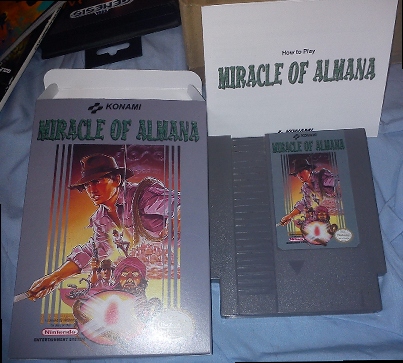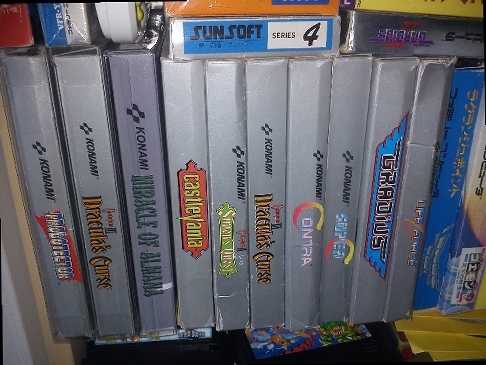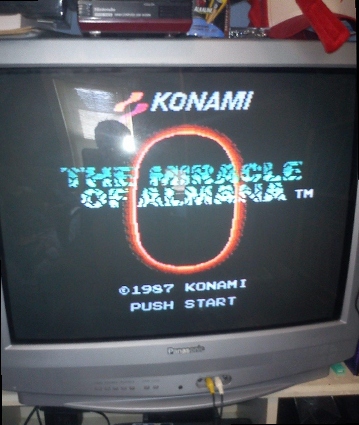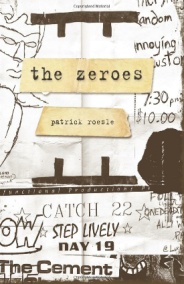
In our
recent interview with Westone founder Ryuichi Nishizawa, we inquired about their cancelled game Aquario of the Clockwork (also known under its Japanese name, Tokei Jikake no Aquario / 時計じかけのアクワリオ). He pondered whether players would be interested in playing this long lost game, potentially as part of a Sega Vintage Collection. After the interview, Nishizawa delved into his company's archives and discovered the source code. It would be fascinating if this title were finally published after nearly twenty years, but precious little is actually known about the game. (The screenshot above is the only one currently in existence on the internet.) In this post, I've assembled all information currently in English about this game, in hopes to generate some interest. Most of this is taken from this
Lost Levels forum post, with the interviews translated thanks to Johnny Undaunted.

An image from the Aquario source, posted on Nishizawa's Twitter account
Aquario of the Clockwork was developed in 1992/1993 and was to be the last arcade game by Westone. There were some location tests held in Ueno and Shinjuku, but the game tested poorly, and the release was cancelled. Any notes around this time seem to blame it on the popularity of Street Fighter II, wherein any game that wasn't a 2D versus fighter was left in the dust.
According to
an interview with composer Shinichi Sakamoto:
It was going to be similar to Monster Lair. It was going to be a forced side-scrolling game, but with a bit of a cooperative multiplayer mode. It was originally going to be a 2-player game, but then we decided to add a third player as well. The three characters consisted of a boy (named Hack Rondo), a girl (Elle Moon), and a robot (Gash). The method of attack was by stomping on enemies and then grabbing them to throw them out. Oh, I think you could even catch enemies thrown by other players as well or something like that. You could even head butt thrown enemies thrown at you.
Most of the other notes are thanks these notes from a Japanese gamer that were posted a few years back:
*June 14, 1993
My first impressions of the game were simply that it was "pretty and cute". I imagine this feedback must had been quite difficulty for Westone to accept, as they were pretty aware that they weren't making much of an impression as a game company at that point.
Aquario was a Super Mario Bros.-type side-scrolling action game. The controls originally consisted of three action buttons ("throw", "jump" and "invincibility").
Enemies are attacked first by jumping over them, rendering them unconscious. When the player moves towards an unconscious enemy, he automatically picks it up. At this point the player can throw the enemy by pressing the throw button. Enemies that are thrown flies off in a single horizontal line and are defeated by flying off-screen or being bashed to a wall. Thrown enemies can be used to knock other enemies unconscious as well. Moreover, by holding the joystick upwards, enemies can be thrown to the top of the screen as well.
Pressing the invincibility button makes the player invincible to enemies for a brief period. In the upper portion of the screen, there's an invincibility gauge underneath the score display and when it reaches zero, the player's invincibility will wear off. The gauge can be replenished by picking up items.
The key to the exit of each stage is kept by a sub-boss. By defeating the sub-boss, the player can obtain the key and use it to enter the boss' lair. Each boss can be defeated by jumping over him repeatedly or by throwing his henchmen to him. The boss of the first stage in this version was a crab.
The game featured a 2-hit points per life system similar to Ghosts 'n Goblins and Midnight Wanderers, in which getting hit once would make the player's clothes look tattered, and then getting hit a second time would make him lose a life. The player's clothes can be restored by picking up a health power-up.
* Impressions of the June 14 version.
This version was really difficult. I couldn't defeat the crab boss after several plays. It was a pretty difficult experience for novice players, since enemies move quickly and a lot of fake-outs are used by them. The invincibility button was difficult to use as well. Because it was difficulty to predict what kind of dangers would face in these kinds of action games, getting through them was simply a matter of "pressing the button on time". There were also unfair trap placement as well, such as the snapping trap in Stage 1. The game was still unfinished at the time, as there were bugs such as glitched text display during the playing instructions at the start of the game. However, the colorful graphics really caught my attention.
A revised version of the game was shown a few months later retooling the invincibility mechanics:
*August 15, 1993
Another location test for Aquario was held, this time in the comic book shop near the Spo-Lan in Shinjuku Nishiguchi. The content of the game were greatly altered since the last location test, to the point that the game was almost completed.
The number of action buttons was reduced to only two (punch and jump). This time, invincibility is only provided by a power-up item for a limited period (similar to the Starman in Super Mario Bros.). The invincibility gauge was replaced with a 1UP gauge that gives player an extra life when filled and it seems enemies are now defeated by knocking them unconscious with a punch, moving onto the unconscious enemy, and then throwing them. It was also possible to defeat enemies by simply punching an unconscious enemy further until he disappears. Since players were irritated that they were unable to defeat enemies quickly in the June 14 version, the resulting changes in this version made the game easier to play in longer periods. Perhaps because of this, the game was still deemed unsafe to release to the market just yet.
--
This makes it all sound rather fascinating. It seems to be sort of a spiritual descendant of Monster Lair, and the mechanics make it out to be something like a Treasure title. Plus, Westone has some amazing artists. Wonder Boy 3: The Dragon's Trap/Monster World II for the Master System and Monster World IV for the Mega Drive have some of the most outstanding art and animation on their respective platforms, so imagine how fantastic this must've looked on the
Sega System 18 board, which featured games like
Moonwalker and
Shadow Dancer.
So, as
Nishizawa warns, he's not sure if all of the necessary files are included in the disk he found (or which revision of the game was contained). And while there was some interest bandied about by Sega producer Yousuke Okunari (who helmed up the excellent PS2 Sega Ages collection and the recent Sega Vintage Collection) and
M2 president Naoki Horii (who develops the emulators for these collections),
Okunari also warns that nothing is set in stone as far as production.
So assuming the source code is complete enough and it can be ported, what we can do to support the release of this game? Well, for starters, vote with your dollars and purchase the Monster World Vintage Collection games on the XBLA, PSN and Wii Virtual Console. (Just buy all of them in general, in fact - we could certainly use more of them in general, they're fantastic collections.) If you have Twitter,
respond to Nishizawa's tweet and retweet it. (Some responses can be found
here.) And join the
Monster World Fan Page on Facebook, and write on the wall. Nishizawa reads and responds to the posts, so he is definitely listening to any feedback! There is also a
thread on NeoGAF discussing its release.

If you want to support it in a roundabout way, also check out the
downloadable soundtrack at EGG music, which was released a few years ago. Although the site supports English, getting it work properly is difficult (it kept removing the item from my shopping cart so I left it in Japanese.) It does allow Paypal, so it is possible to purchase for anyone outside of Japan. Due to network constraints I had to download the tracks one-by-one though - the site is not terribly intuitive.
The music is composed by Shinichi Sakamoto, who also worked on most of the Wonder Boy games. It is a bit pricey though - the current exchange rate puts it at a bit under $25 US. I ponied up the cash, and while it's not amazing, it's still quite catchy. There are some samples there - it has more in common with his Monster Lair music than any of the Monster World games, with a distinct dance/house flavor to most of the tracks, but they're decent enough, and the included bonus arrangements are quite good.

An illustration of Elle Moon, drawn by the original artist, Mina Morioka
It's a little hard to drum up hype for this game since so little is known about it, but hopefully some more assets will be released in the future, and perhaps a future Sega Vintage Collection will feature Aquario of the Clockwork (perhaps it would be nice bundled with the
rest of the Wonder Boy games...?) After all, there's been a revival of retro-style games in the past few years - why not release an authentic game from the time period?





























